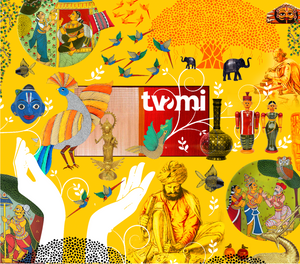Koudi
There are no products matching your search
View all productsKoudi patchwork quilts - love and nostalgia sewn by hand
As you move from one region of India to another, a craft certain to grab your attention in a changing form is that of hand-stitched quilts. Easily distinguishable from the factory-produced duvets or comforters, the hand-sewn quilts carry the weight of traditions. Barring few similarities in the process, and the affection with which they are sewn, each hand-quilting craft form is unique. The patterns, designs and stitching techniques are often exclusive to the region. They reflect the vibrancy and customs of their place of origin. One such beautiful style, native to Uttara Kannada district of Karnataka is that of hand-stitched patchwork quilts, popularly known as koudis.
Even though today, one may find koudi bed covers, pillow covers, throws, rugs, picnic spreads and the likes, traditionally it was practiced to make only quilts. The genesis of this craft form may be traced back to many generations of the communities residing in the region. Conventionally made using old clothes and fabrics, koudi-making has always been a labour of love. A newly wed bride, leaving her maternal home, would customarily carry one or more koudi quilts - a tradition which is followed even today. Affectionately sewn by the bride’s mother, the quilts seemingly bring a familiar sense of comfort along with nostalgia and fond memories.
The craft has traditionally been practiced, taught and passed on by older women to younger women in the family. After finishing their daily chores, women would pick up the task of quilting. This would often become a small social congregation as several women would gather together, completing their respective koudis and chatting about life and more. Each koudi could take anywhere between a few weeks to several months to finish, depending on the size, design and finesse. Whether it is to be used as wrap a for a new-born child or toddler, or a queen-size or king-size quilt, the tedious task of hand-stitching one, requires much skill, patience, dedication and vision to complete.
Koudis are usually segregated into 3 layers - top, middle and bottom. The top layer carrying the distinct geometric or abstract designs is made using small scraps cut out of upcycled fabrics. The middle layer of batting, would conventionally comprise of multiple layers of used sarees, lungis or other such clothes. In contemporary times, polyester fillings are used as well. The batting defines the thickness and warmth of the quilt. The bottom layer of a single piece of fabric serves as the quilt’s backing. Usually cotton fabrics are used across the three layers, although other types may be used as well.
A unique aspect of koudi-quilting is that it is stitched from the outside towards the centre. To start, a border from a sari or dupatta is cut out. Next, the back of the quilt is laid on the floor with the batting layers laid on top of it so the inside faces the quilter. The border is attached all around the quilt with short running stitches. Once the border is done, the top-layer patches are attached, starting with each corner first. This is done by folding in about half an inch of two sides of the patches and starting the line of running stitches on the patch. Another patch of colour is added when you come to the end of the previous one and the running stitch goes on. Each time the patch is added a back stitch is taken to secure the patch.
Once the corner patches are in place is when the vision of these women really comes to light. The quilt is sewn inwards in lines that go round the quilt – like concentric squares. Using their design sense and presence of mind, they start stitching fabrics in a manner such that the final patchwork pattern, motifs and colours appear symmetrical or as intended on opposite ends of the quilt. Once the first round of patches with stitches are done, the work gradually progresses towards the inner square. The same method of attaching new patches is used till the centre, with the exception that stitches can now be run from the left to right instead of going round the quilt.
The more humane touch of this craft appears as one reaches the centre. The women who pour their love and affection into the quilt, consider it to have a soul and life. Thus, traditionally, before closing the final stitch at the centre, a tiny bit of cooked food like a granule of rice or small piece of chapati would be put in the quilt, to feed it. The quilts prepared by seasoned quilters is a sight to behold. Beautiful patchwork aside, the precision in their stitchwork makes it hard to believe that it has been achieved by hand and the power of their naked eye.
Koudis are more than an embodiment of an extraordinary craft, instilled with love, warmth and strong socio-cultural beliefs. While in the years gone by, it provided women a means of artistic expression, today, it offers them an avenue of hope and empowerment. With upcycling of materials and sustainability at its core, it is a fine example of how many traditional practices were inherently environment conscious. A fine example of circular economy practices, it signifies how much more we can learn from our rich heritage to solve various contemporary issues.

